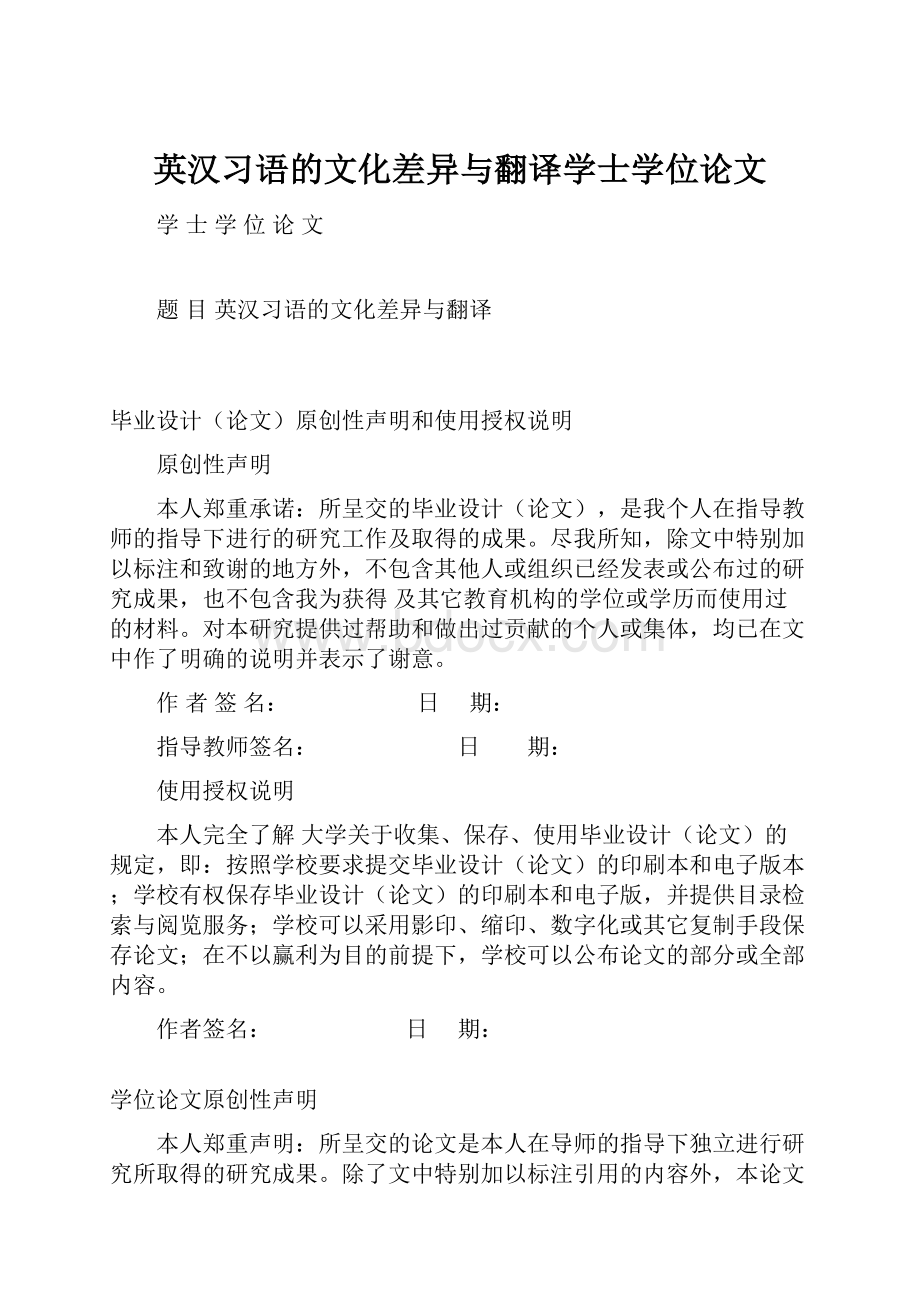英汉习语的文化差异与翻译学士学位论文.docx
《英汉习语的文化差异与翻译学士学位论文.docx》由会员分享,可在线阅读,更多相关《英汉习语的文化差异与翻译学士学位论文.docx(20页珍藏版)》请在冰豆网上搜索。

英汉习语的文化差异与翻译学士学位论文
学士学位论文
题目英汉习语的文化差异与翻译
毕业设计(论文)原创性声明和使用授权说明
原创性声明
本人郑重承诺:
所呈交的毕业设计(论文),是我个人在指导教师的指导下进行的研究工作及取得的成果。
尽我所知,除文中特别加以标注和致谢的地方外,不包含其他人或组织已经发表或公布过的研究成果,也不包含我为获得及其它教育机构的学位或学历而使用过的材料。
对本研究提供过帮助和做出过贡献的个人或集体,均已在文中作了明确的说明并表示了谢意。
作者签名:
日 期:
指导教师签名:
日 期:
使用授权说明
本人完全了解大学关于收集、保存、使用毕业设计(论文)的规定,即:
按照学校要求提交毕业设计(论文)的印刷本和电子版本;学校有权保存毕业设计(论文)的印刷本和电子版,并提供目录检索与阅览服务;学校可以采用影印、缩印、数字化或其它复制手段保存论文;在不以赢利为目的前提下,学校可以公布论文的部分或全部内容。
作者签名:
日 期:
学位论文原创性声明
本人郑重声明:
所呈交的论文是本人在导师的指导下独立进行研究所取得的研究成果。
除了文中特别加以标注引用的内容外,本论文不包含任何其他个人或集体已经发表或撰写的成果作品。
对本文的研究做出重要贡献的个人和集体,均已在文中以明确方式标明。
本人完全意识到本声明的法律后果由本人承担。
作者签名:
日期:
年月日
学位论文版权使用授权书
本学位论文作者完全了解学校有关保留、使用学位论文的规定,同意学校保留并向国家有关部门或机构送交论文的复印件和电子版,允许论文被查阅和借阅。
本人授权 大学可以将本学位论文的全部或部分内容编入有关数据库进行检索,可以采用影印、缩印或扫描等复制手段保存和汇编本学位论文。
涉密论文按学校规定处理。
作者签名:
日期:
年月日
导师签名:
日期:
年月日
注意事项
1.设计(论文)的内容包括:
1)封面(按教务处制定的标准封面格式制作)
2)原创性声明
3)中文摘要(300字左右)、关键词
4)外文摘要、关键词
5)目次页(附件不统一编入)
6)论文主体部分:
引言(或绪论)、正文、结论
7)参考文献
8)致谢
9)附录(对论文支持必要时)
2.论文字数要求:
理工类设计(论文)正文字数不少于1万字(不包括图纸、程序清单等),文科类论文正文字数不少于1.2万字。
3.附件包括:
任务书、开题报告、外文译文、译文原文(复印件)。
4.文字、图表要求:
1)文字通顺,语言流畅,书写字迹工整,打印字体及大小符合要求,无错别字,不准请他人代写
2)工程设计类题目的图纸,要求部分用尺规绘制,部分用计算机绘制,所有图纸应符合国家技术标准规范。
图表整洁,布局合理,文字注释必须使用工程字书写,不准用徒手画
3)毕业论文须用A4单面打印,论文50页以上的双面打印
4)图表应绘制于无格子的页面上
5)软件工程类课题应有程序清单,并提供电子文档
5.装订顺序
1)设计(论文)
2)附件:
按照任务书、开题报告、外文译文、译文原文(复印件)次序装订
英汉习语的文化差异与翻译
摘要:
习语是人类语言文化的结晶,共翻译更是引起了翻译界的普遍关注。
习语来源于各种不同的文化创迨之中,它负载了很多文化内涵。
它们能够直接而深刻地反映出不同语言的文化因素。
英语和汉语走当今世界上两种拥有最多伎用孝的语言,二孝都拥有大量的习语。
对英汉习语中文化因素的误解常常迨戍英汊跨文化交际的失败。
因此对比研究英汉刁语中的文化因素意义深远。
对比研究走进行语言文化研究的重要方法之一。
近几十年来,英汉对比研究在我圉获得了长足的发展。
虽然一些学者进行过英汉习语对比研究,但是由于习语中的文化因素的复杂性,还有必要从文化角庋对英汉习语进行更多的研宪。
本论文的目的就是进行英汉习语文化差异的对比研究以及翻译。
本文对英汉习语中的文化因素的对比研究揭示了这样一个事实,要掌握两种语言,必须掌握两种文化。
除了引论和结尾,论文划分为三章。
首先,作者明确了英汉习语的定义和种类。
紧接着的第二章从文化角庋对英汉习语进行对比分析,作者分别从不同的居住环境、不同的历史典故、不同的宗教信仰和不同的传统文化方面研究英汉习语的差畀。
第三章是翻译理论的学习及其在实践中的应用,介绍了诸如:
直译、意译、苴译加意译等翻译方法。
作孝希望通过对习语的对比研究激发学生对翻译的热情,提高学生的翻译能力,培养大家的跨文化意识,最终服务于英语教学,取得更好的教学效果。
关键词:
英汉习语习语翻译对比研究
Contents
Introduction1
I.DefinitionofChineseandEnglishIdioms2
1.1DefinitionofChineseidiom2
1.2DefinitionofEnglishidiom3
1.3.1Setphrases3
1.3.2Commonsayings4
1.3.3Proverbs4
1.3.4Two-partallegoricalsayings4
1.3.5Vulgarexpressions5
1.4ClassificationsofEnglishidioms5
1.4.1Idiomaticexpressions5
1.4.2Proverbs5
1.4.3Slangs……………………………………………..................................6
II.CulturalSimilaritiesanddifferencesinEnglishandChineseIdioms7
2.1CulturalSimilaritiesinEngishandChineseIdioms7
2.2CulturalDifferencesinEnglishandChineseIdioms8
2.2.1DifferencesRootedinGeographicalConditions8
2.2.2DifferencesRootedinSocialCustoms8
2.2.3DifferencesRootedinReligiousBeliefs8
2.2.4DifferencesRootedinHistoricalandLiterayallusions...........................9
III.TranslatingMethodsofEnglishandChineseIdioms10
3.1Literaltranslation10
3.1.1LiteraItranslationexamplesofsetphases:
10
3.1.2Literaltranslationexamplesofcommonsayings:
10
3.1.3LiteraItranslationexamplesofproverbs:
11
3.2Liberaltranslation............................................................................................11
3.2.1Two-partallegoricalsayings'translation11
3.2.2Idiomoriginatedfromhistoricalevents,fables,etc...............................12
3.2.3Idiomwithdimimages12
3.3Combinationofliteralandliberaltranslation13
Conclusion14
References15
Introduction
Cultureandlanguagedependoneachotherforexistence.Itisimpossibletotranslateaforeignlanguagetextwithouttakingintoaccountthecultureitembodies.Inthissense,translationbecomesaculturalexchangeasacross.linguistic,cross,culturalandcross.socialcommunicativeactivity.
Idioms,formedinaparticularperiodandpassedonfromgenerationtogeneration,reflectvariousculturalelements.Theyarecomparativelyfixedinmattersofmeaningandstructure,thatis,themeaningofidiomcannotbedeterminedbythemeaningsofitswords,Toletthewholepeoplebefamiliarwithothernations,cultures,itisreallyvaluabletotranslatevariousidiomsintodifferentlanguages.However,idiomisdifficulttotranslateinthatitisofpeculiarculturaloriginandthereforereflectsclearlynationalorculturalcharacteristics.Itisimpossibleforthetranslatorstoavoidculturalelementsinidiomtranslation.ChineseandEnglishbelongtodiferentlanguagefamilies.Althoughtheysharemanythingsinculture,eachlanguagehasitsownspecifcculturalproperty.TherearesomesimilaritiesbetweenEnglishandChinesecultures,whichmakeidiomtranslationpossibleandeasy.However,thereismoredissimilaritybetweentheChinesecultureandtheEnglishculturethansimilarities.Accurateunderstandingandpropertranslationofidiomisthekeytothebreakthroughofbarriersininterculturalcommunication.Thispapertriestoanalyzeidiomsfromtheperspectiveofcultural,translationwiththepurposeofillustratinghowculturalfactorsinfluencethetranslationandcomprehensionofidioms,andexploringeffectiveprinciplesandstrategiesofidiomtranslation.
.DefinitionofChineseandEnglishIdioms
Idioms,conventionalizedmultiwordexpression,existasasub-groupofvocabulary.Refinedandacceptedbylongusage,idiomshavebeendescribedasthecrystallizationoflanguage.Idioms,astheessenceoflanguage,arefrequentlyusedinliteraryworksandourdai1ylife。
NevertheIess,itisnoeasyjobtogiveaclear-cutdefinitiontoit.
1.1DefinitionofChineseidiom
AccordingtotheChinesedictionaries:
《现代汉语词典》(ModernChineseDictionary)byCommercialPressand《新华词典》(xinhuaDictionary)byCommercialPress,AChineseidiom,whichiscalled习语,isdescribedas"afixedphrase,canOnlybeusedasawholeunit,noelementinitcanbechangedatrandom,andusuallycan'tbeanalyzedbyordinaryregularword¨formation."
Chineseidiomisnewlydescribedas"aChineseidiom,constitutedbywords,re1ativelyfixedinstructure,isanarrative1anguageunitwhichcanperformamultiplefunctions."
Bothdefinitionsstresstwofeaturesthatanidiommanifests.First,anidiommustbeusedasawho1eunit,andthephrasehasnomeaningbyitsindividualwords,like不管三七二十一,胡说八道etc.Second,noelementinanidiomcanbechangedatrandom.Forexample,wecanon1ysay垂头丧气,butnot低头丧气though“垂”and“低”hasthesamemeaning;八九不离十,not七八不离九.Third,intermsofgrammaticalfunction,bothanidiomandawordcanserveaspartsofasentence,whileanidiomcanbeusedasanindependentsentenceandfrequent1yquotedin
differentcontexts.
1.2DefinitionofEnglishidiom
AccordingtothelatestWebster'sNewWorldCollegeDictionary,thethirdedition,''idiom''is''aphrase,constructionorexpressionthatisrecognizedasaunitintheusageofagivenlanguageandeitherdiffersfromtheusualsyntacticpatternsorhasameaningthatdiffersfromliteralmeaningofitsparttakentogether.''InCambridgeAdvancedLearner'sDictionargidiomis''agroupofwordsinaf1xedorderthathaveaparticularmeaningthatisdifferentfromthemeaningofeachwordunderstoodonitsown'''Longmangivessuchadefnition:
''agroupofwordswithaspecialmeaningwhichisdifferentfromthemeaningoftheindividualwords.''Oxforddefinesidiomasfollows:
"phraseorsentencewhosemeaningisnotclearfromthemeaningofitsindividualwordsandwhichmustbelearntasawholeunit.''
Amongalloftheseexplanations,thefirstoneisthecommonestandthemostpopularmeaningoftheword,'idiom''.Fromtheabovedefinition,wecanseethatthemeaningofanidiomcannotbeunderstoodonlybyitsindividualwords,butbyawholeunit.
1.3ClassificationsofChineseIdioms
IdiominChinese,inthebroadsense,canberoughlyc1assifedintosetphrases,commonsayings,proverbs,two-partallegoricalsayingsandvulgarexpressions.
1.3.1Setphrases
Setphrases,whosestorehouseseemstobeinexhaustible,playanimportantroleinourmothertongue.Generallyspeaking,aChinesesetphraseisa''wellestab1ishedf1xedphraseorshortsentencewithtersesty1eandpithymeaninghabituallyusedbypeop1eforalongtime''.Chinesesetphrasesare''phraseswith2p1us2patternwithdescriptiveorinformativefmction.''(Wen2005:
290).Fromtheabovedefnition,itisclearthatfour—characterwithtwo-meterinpoetryformisessentialattributeofchinesesetphrases,whichdistinguishesChinesesetphrasesfromothertypesofChineseidioms,suchasproverbscommonsayingsorallegoricalsayings.Chinesesetphrasesmaypossessthreefeatures:
comprehensiveness,c1assicandfusion。
Suchastheidiom“倾盆大雨”,referringtorainingcatsanddogsorrainingheavilywhichisusedtodescribetheimageofraininginfigurativelanguage.Theidiom“卧薪尝胆”meanstosleeponbrush-woodandtastegalltoundergoself-imposedhardshipssoastostrengthenone'sresolvetowipeoutanationalhumiliation.Thephrase“胸有成竹”meanstohavebamboosinone'schest,implyingtohavehadreadyplansordesigninone'smild.
1.3.2Commonsayings
Chinesecommonsaying,widelyusedinthecolloquial1anguage.Mostofthem
arecreatedbyworkingpeop1eandreflecttheir1ifeexperiencesandwishes.Commonsayingsare"Non-four-character,non-informativeexpressions1ikeproverbs,anidiomaticalunitwhichhasdescriptivefunction".
Thecommonsaying"老油条"referringtoanolddeep-friedtwisteddoughsticks,isoftenusedtodescribeahard-boiledslipperyperson.Theidiom‘‘不管三七二十一”whichmeanstoconsidernothingatall,isoneoftheconventionalcases.
1.3.3Proverbs
Chineseproverbisastockexpression,too.Chineseproverb,widesρreadamongordinaryρeople,isconclse,fixedphraseorsentenceinwhichaprofoundtruthisimpliedbysimρleandinformallanguage.Anappropriateuseofproverbswilladdtoth